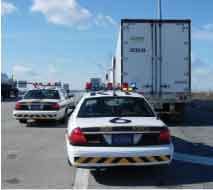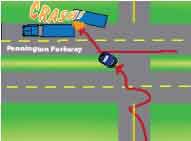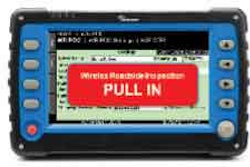CVSA: Fewer funds could raise truck-related accident rate
The Commercial Vehicle Safety Alliance last month warned Congress that funding commercial motor vehicle safety programs at lower-than-current levels would weaken state enforcement efforts, and that large truck-related injuries and deaths could tick upward.
 FMCSA data indicates that roadside inspections and traffic enforcement have a clear and substantial safety benefit and are providing a tremendous return on the investment of tax dollars.
FMCSA data indicates that roadside inspections and traffic enforcement have a clear and substantial safety benefit and are providing a tremendous return on the investment of tax dollars.“We are finally heading in the right direction with a downward trend in heavy truck fatalities,” says Capt. Steve Dowling, CVSA president. “With the economy picking up and highway traffic increasing, I don’t believe we could continue that trend if the Motor Carrier Safety Assistance Program and state safety grant funds are cut.” Dowling was speaking before the House Subcommittee on Highways and Transit during a two-day hearing on the reauthorization of the nation’s surface transportation programs.
CVSA urged Congress to continue to focus funds on enhancing the MCSAP, as there is Federal Motor Carrier Safety Administration data indicating that roadside inspections and traffic enforcement have a clear and substantial safety benefit and are providing a tremendous return on the investment of tax dollars. “Through targeted investments, we can improve upon our successes and provide the necessary tools for enhancing enforcement’s ability to remove the unsafe operators from the road,” said Dowling. “We recommend making the safety grant programs more flexible and streamlining the administrative and delivery processes to reflect the reality of today.”
Dowling outlined a number of areas to enhance motor carrier safety and recommendations for streamlining and providing a focus to programs, including flexibility and streamlining of motor carrier safety grant programs, maintenance of effort, bus safety, carrier exemptions from motor carrier safety regulations, truck size and weight, motor carrier safety technologies and carrier registration, credentialing and data integrity.
According to CVSA, about 75 percent of all large truck fatalities are multivehicle crashes between cars and large trucks, and flexibility in the use of funds is critical to targeting the problems effectively.
IN BRIEF
* The Federal Motor Carrier Safety Administration removed 289 passenger buses or drivers as a result of 2,782 surprise passenger carrier safety inspections conducted nationwide over a nine-day period with state and local law enforcement partners. From March 28 through April 6, out-of-service violation citations were issued to 156 drivers and 262 vehicles. Previously, from March 12 to March 28, an estimated 3,000 inspections resulted in nearly 300 passenger carrier vehicles being put out of service.
* The Federal Motor Carrier Safety Administration placed Pennsylvania-based passenger bus company Super Luxury Tours out-of-service, suspended the company’s U.S. Department of Transportation operating authority and prohibited it from operating in interstate transportation services for violating insurance requirements for commercial motor carriers.
* Gordon Trucking Inc. team drivers James and Jo Bailey achieved the company’s first 5 million safe miles. The Baileys, residents of Eugene, Ore., have been teaming for GTI since 1994, with James starting as a solo driver in 1984.
* Schneider National driver Mark DeSotel, a resident of Fairfax, Iowa, became the third driver in company history to achieve 4 million consecutive accident-free miles. DeSotel has been a driver for the company since 1976.
* The 28th annual Goodyear North America Highway Hero is Tilden Curl, a truck driver from Olympia, Wash., who helped save the lives of two people in a car that had come to a stop on railroad tracks, including pulling the unconscious driver from his car before it was struck by an approaching train. Curl accepted the award and a $10,000 U.S. Savings Bond.
PREVENTABLE OR NOT:
Out of the frying pan, into the fire for Doe
Softly humming the “Backhaul Blues,” doubles driver John Doe peered intently through a veil of rain that somewhat limited his view of Pennington Parkway, a four-lane highway with a grassy median, posted at 65 mph. Due to the inclement weather, Doe was cruising at 45 mph in the far right lane. Traffic was light. The time was 1 p.m. Reaching for his Thermos, Doe took a swig of the cocoa and coffee mix and … what the heck?

Armed with the reflexes of a cobra, Doe spun the wheel to the right, averting a collision but … Yikes! CRASH!!! Alas, Doe’s rear trailer had succumbed to a crack-the-whip scenario, and now rested on its side in the ditch! Unscathed, Clydesdale’s Benz disappeared into the distance, trailing blue smoke.
Since Doe contested the preventable-accident warning letter from his safety director, the National Safety Council’s Accident Review Committee was asked to render a final decision. NSC promptly ruled in Doe’s favor, noting that he’d avoided being sideswiped and couldn’t have anticipated Clydesdale’s attack.
CAPTION: John Doe successfully passed a slow-moving straight truck on the divided highway only to encounter a car that sped across the median toward him. Was this a preventable accident?
Traffic deaths at 61-year low
Despite a significant increase in the number of miles Americans drove in 2010, traffic fatalities in 2010 fell to the lowest levels since 1949, according to a report by the National Highway Traffic Safety Administration. NHTSA says traffic fatalities fell 3 percent between 2009 and 2010, from 33,808 to 32,788. Since 2005, fatalities have dropped 25 percent, from a total of 43,510 fatalities in 2005. The same estimates also project that the fatality rate will be the lowest recorded since 1949, with 1.09 fatalities per 100 million vehicle miles traveled, down from the 1.13 fatality rate for 2009. The decrease in fatalities for 2010 occurred despite an estimated increase of nearly 21 billion miles in national vehicle miles traveled.
The greatest drop in fatalities occurred in the Pacific Northwest states of Washington, Oregon, Idaho, Montana and Alaska, where they dropped by 12 percent. Arizona, California and Hawaii had the next steepest decline, nearly 11 percent.












